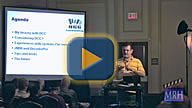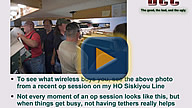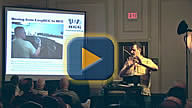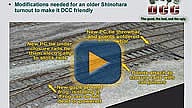DCC: The good, the bad, and the ugly - MRH Theater
DCC: The good, the bad, the uglyJoe Fugate recounts the highlights (both good and bad) from his 15 years of DCC experience in this clinic from the 2008 NMRA National Convention in Anaheim. Segment 4 is now available! |
 |
|
|
|
|
|
|
|
|
|
Playback problems? Try playing this video from our mirror site. |
|
|
|
|
|
|
|
|
Playback problems? Try playing this video from our mirror site. |
|
|
|
|
|
|
|
|
Playback problems? Try playing this video from our mirror site. |
|
|
|
|
|
|
|
|
Playback problems? Try playing this video from our mirror site. |
|
|
|
|
ADDITIONAL DCC RESOURCES
|
|
>> Posts index
Navigation
Journals/Blogs
Recent Blog posts:




Comments
Current is current - and a short is a short
Irv:
Current is current, and a short is a short - so sure - the bulbs will work the same on N scale. Question is - what's the typical N scale loco's current draw? I would suspect it's slightly less than HO. This may actually be better - since 2.1 amps can be a bit on the light side if you get a modern diesel train in HO with a large consist and sound decoders - if the bulb starts to glow dull orange when running trains then you need to up the current limit as described here. Scroll past the video and read the other posts in the thread.
The 1156 bulbs will limit the short current to 2.1 amps, which is much better than 5 amps - and that's even better on an N scale layout with the smaller locos. I would expect N scale locos and rolling stock would be even less tolerant of 5 amps in a short than HO equipment would be.
Joe Fugate
Publisher, Model Railroad Hobbyist magazine
Read my blog
Current is current
None of my locomotives are equipped with sound decoders at this point. All of them will have DCC decoders connected to their motors though. I also do not anticipate consisting them at this point primarily because I will be using SD70MAC and SD80MAC locomotives as primary power on 15 car trains for the most part. I may need to use double headed locomotives on the helix that climbs between the two levels that the layout will eventually have. That will probably be its own power district since the climb will be something like 16-18 inches. I will probably have 3 power districts in addition to the car float yards which will be controlled from my Digitrax Zepher. The rest will be run off of 5 amp boosters which should have plenty of juice for the rest of the layout. I will use the 1156 bulbs at least initially. But I will watch to see what happens.
Irv
Less the 0.5 amp
My understanding is a reasonable N scale loco (sans sound) draws less then 0.5 amp. I think its more like 0.2 for a modern mechanism. One more reason to love newer locomotives. A 5 AMP booster provides more then enough power any modest home N scale layout and a 2-3 amp "starter" set is going to get a lot more mileage then in a larger scale.
On the other hand, tiny rails make maximizing feeders and keeping track clean more important to make sure that power gets to the loco.. You figure the code 40 track I put together the other day will have twice the resistance the code 83 track in HO that is so popular. Both the loco and the track are more likely to be damaged by an unmitigated short.
Chrs
“If you carry your childhood with you, you never become older.” My modest progress Blog
Great Website
I stumbled upon this website the other day, registered immediately, and have watched the videos on DCC. Just completed the benchwork on a new HO layout and now starting to lay out the trackplan. I anticipate purchasing a DCC system sometime this spring, so the DCC videos were timely. I also enjoyed the first edition of MRH magazine. Great job and keep up the good work. Gotta love trains!
Episode 4 of the Good, The Bad and the Ugly about DCC
I just fished watching the 4th part of this presentation and It was as good as all the rest. It makes one take notice of all of the things you never get to see or hear about until after you've purchased an installed your system. I just wish that more could have been said about other DCC systems than the one Joe uses. I don't use the NEC system and neither does my club. They have Digitrax DCS200 system which I think is an 8 - 10 amp capacity system that powered our red, blue, yellow and green lines. Those lines could be used either for DCC or DC since we have members who use DC instead of DCC locomotives. The power was adequate but even we still had shorts even though we rarely, if ever, used turnouts to send trains to alternative trackage exc ept whe we had our yards attached to the layout. But even then each line had its own yard for use by members to either put their trauns on the tracks or remove them as dictated by the number of people running trains and how long a time each one had to aloted to him for that purpose.
We didn't do operations as much as we did exhibition running sinc emost of those who came to see us run trains didn't understand or know what operations are to begin with. Unfortuantely, most people today have no idea what trains do or why they are necessary in the modern world primarily because they rarely get see trains at work and never learn about them either in school or at work.
I would like to see somehing like what Joe has presented from those who use other systems like Digitrax, Easy DCC, Lenz and some of the other manufacturers. There is room for all of them in my way of thinking.
Irv
You discounted Digitrax as a choice
for your layout when you selected your replacement system. In the video, you said one of the drawbacks of Digitrax was that you had to wire an additional bus around your track, but you did not explain what this additional bus was for. Can you elaborate? Ironically, you did end up wiring an extra bus around your layout, as you explained in the segment on the current limiting lightbulb wiring scheme that you adopted.
Regarding the light bulbs, I have heard talk of them before but never really understood the real benefit of them before I saw your short video demonstration. Then the light (bulb) went on! I am in N scale, have 4 power districts and I have wired a pair of feeders (one per rail) to just about every piece of flex track. That would make the insertion of light bulbs very easy: cut both tracks between feeders and insert the bulb into the feeder to one rail.
Finally, this is a great website - thanks!
Steve
I use wireless throttles ...
I was using EasyDCC wireless throttles that did not require plugging in to acquire locos. To move to Digitrax's current wireless offering, I would have needed to run LocoNet around the layout.
I had already added the 3rd power bus wire for the light bulbs in 2000, so if I was to adopt Digitrax's wireless offering in 2007 when I was in the market for a new DCC system, would have needed to run a new LocoNet bus around the layout.
By going with NCE wireless, which does not need to be plugged in to acquire locos, I saved myself the hassle of running LocoNet around the layout. It appears Digitrax's new duplex wireless that they have in testing now will no longer need to be plugged in to acquire locos - once again proving my contention that Digitrax's offerings sometimes miss the mark a bit at first, but they eventually get it.
My largest issues with EasyDCC were their price increases, their limitation on dedicated throttle frequencies (16 to NCE's 40+), and their annoying trend away from user friendly features (non-intuitive key sequences and artificial limits on consisting). Once I got a Blueline loco, I realized EasyDCC did not do direct mode programming (NMRA's newest decoder programming standard) via the computer interface either.
Moving to NCE solved all these issues for me and saved me over $800 (versus upgrading all my obsolete and aging EasyDCC equipment) - so I am very pleased with the change.
I still feel the two most user-friendly DCC systems out there are NCE and EasyDCC - and they also have the best wireless systems as well. So if you're into wireless DCC, you can't do much better than to go with NCE or EasyDCC. Both have rock-solid wireless and neither require you to plug in to acquire locos.
Once Digitrax releases their duplex wireless, I expect they will join the ranks of the best wireless DCC on the market.
Joe Fugate
Publisher, Model Railroad Hobbyist magazine
Read my blog
Digitrax goes to sleep...
Irv,
The one thing I've found annoying with Digitrax is that the system goes to sleep if you don't keep jiggling the controller once you've acquired your locomotive. And sometimes if you don't jiggle it for a long period of time, you have to plug to reaquire it. I don't know if this will be as big a drawback if you actually operate your train instead of letting it run around the track like we used to do at the club when the public was watching.
I will one of the first on line to get the new system when it finally comes out. Hopefully that will be before the NMRA Convention in Hartford, but one never knows since they were supposed to realease at last year's convention. Oh well.
Irv
Not wiring control bus
I thought the observation about not having to wire a control bus with duplex radio was an interesting one. I had not considered that benefit a benefit of duplex over simplex. I think on a less monstrous layout you would be able to get away with a couple of strategically placed "aquisition" jacks.
Still, even with duplex radio, unless you can afford enough controllers for everyone I would be hesitant to do away with the control bus entirely. Most of the layouts I visit depend on a few users bringing their own throttles which may or may not be radio depending on what they have at home.
Chris
“If you carry your childhood with you, you never become older.” My modest progress Blog
All my crew knows I have wireless ...
All my crew knows I have NCE wireless, so the NCE throttles they own and bring are wireless, too. Costs a little more, but it still spreads the cost out - and if your layout ever gets so it looks like this (see photo below), then you will quickly appreciate the freedom on NEVER having to plug in EVER.
Joe Fugate
Publisher, Model Railroad Hobbyist magazine
Read my blog